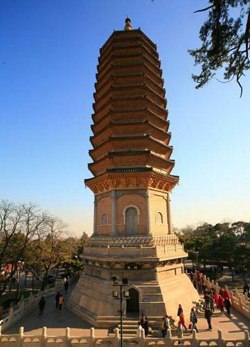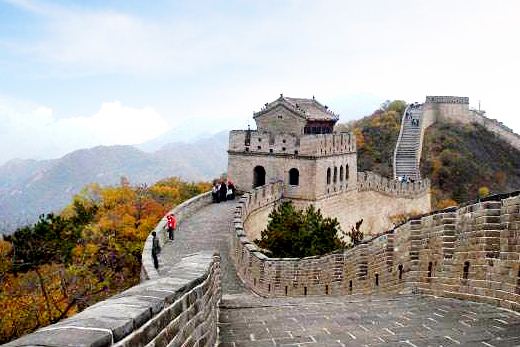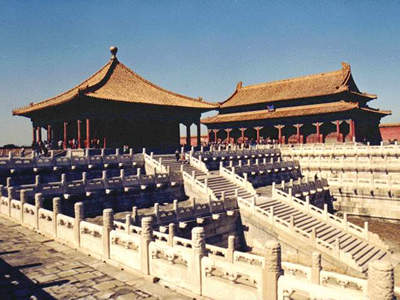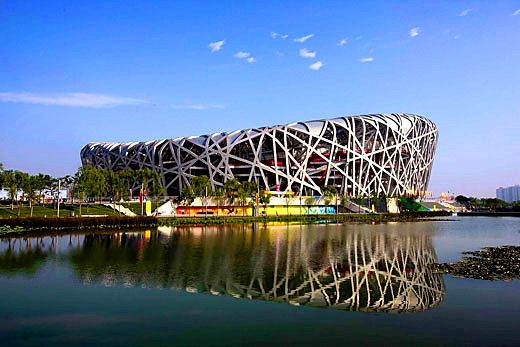The Eight Great Temples is a traditional name given to eight Buddhist temples"nestled among the clouds on Cuiwei Hill and Lushi Hill"in Beijing' s Western Hills district. 
The Temple of Eternal Peace (Chang' ansi)
The Temple of Eternal Peace is situated on the plain at the foot of Cuiwei Hill. Constructed in 1504 during the Ming Dynasty, the temple is comprised of two courtyards, the first containing the Sakyamnuni Hall and the second the Niangniang (a female deity) Hall. The Sakyamuni Hall houses a bronze statue of Guan Yu, a hero of the Three Kingdoms period who was later worshiped as the God of War. Chinese Buddhists worshiped guan Yu as a temple guardian. In the south corner of the covered corridor in the rear part of the hall is a bronze bell cast in 1600 by imperial command. It is perfectly preserved. In front of the Sakyamuni Hall there is an urn-shaped bell struck as part of Buddhist rituals, which also dates from the Ming Dynasty. In the rear courtyard there are two white pines (also known as dragon-claw pines) reputed to date from the Yuan Dynasty.
The Temple of Divine Light (Lingguangsi)
Less than half a kilometer up Cuiwei Hill one comes to the Temple of Divine Light. Originally called the Dragon Spring Temple, its name was changed to the Mountain of Awakening Temple in 1162. In 1428, during the Ming Dynasty, it was restored and resumed its old name, and in1478, it was finally given its present name.
The only extant component of the original temple is the fishpond located behind the halls at the foot of a small cliff. The pond is filled with unusually large and colorful gold fish, some more than half a meter long. It is said that fish wee placed in the pond before 1851.
To the west of the pond is a small kiosk known as the Shuixin (water' s Heart) Pavilion. A spring to the side of the kiosk bubbles with fresh cool water.
The Temple of Divine Light originally contained a number of fine old buildings, carvings and statues, but the Eight-Power Allied Forces destroyed all these when they occupied Beijing in 1900. One notable structure was a large octagonal Liao Dynasty pagoda constructed in 1071 of carved bricks. Originally situated to the east of the goldfish pond, it was called the Pagoda for Entertaining Immortals. All that remains now is its foundation. The pagoda is important in the history of Buddhism in China since, according to the records, when Buddha was cremated all that remained in his ashes were four teeth, one of which was brought to China in the 11th century and placed here. The Liao dynastic history records that Emperor Daozong (reigned 1055-1100) placed the tooth in a pagoda here. After the destruction of the pagoda in 1900, monks searching through the rubble found a stone chest containing a wooden box in which they discovered the Buddha' s tooth. In 855-108 years before the building of the pagoda in 963-the monk Shan Hui carved the words"The Tooth of Sakyamuni,"the date and some Buddhist incantations in Sanskrit on the inner and outer surfaces of the stone chest. The tooth remained in the temple until 1955 when it was removed to the Guangji Temple by the Chinese Buddhist Association and placed in the Hall of Buddhist Relics.
In 1956, the People's Government erected a new 13-story pagoda on the site of the Liao foundation and named it the"Pagoda of the Buddha's Tooth."A row of old monastery buildings to the north of the pond were restored and a visitors' service center was installed. To the northeast is the Mahavira Hall dating from 1920, which was not part of the original temple. The two Ming-style stone tables in front of the hall are also later copied.


 About Beijing
About Beijing 


